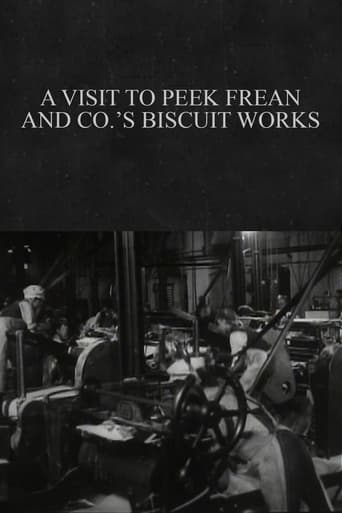JoeytheBrit
The name Peek Frean is as familiar to most British people as Ford is to Americans. They've been making biscuits for a long time and so it is quite interesting to see the manufacturing process from over one hundred years ago. This well-produced documentary follows the process from the arrival of ingredients such as milk and flour to the washing of returned biscuits tins prior to re-use and finally on to the horse-drawn wagons carrying the biscuits through the early-morning city streets for delivery to retail outlets. Two things stand out about this film: the number of people required to produce a tin of biscuits (probably ten times the number required in these automated times) and the frank curiosity of a couple of the men working on the production line. It's probably a little overlong, but this early documentary is fascinating nonetheless. It's also in very good condition for its age.
bob the moo
Starting with the delivery of raw material and finishing with the shipping of finishing products to the point of public sale, this early British documentary is slightly interesting in the way that we get to see an industrial process from over a century ago and contrast it with today's working environment. In regards what the process is then, it is a shame that it is something as bland as biscuit manufacture because really there weren't loads of EHS things jumping out at me in the way they often do in some old footage like this. Indeed it is fair to say the whole process is pretty dull in terms of what you can see.However where the film is quite engaging is if you think around what you are watching and the challenges in getting it on film. The old building is clearly large and dark but yet it is really well lit up and filmed very clearly throughout. As such it is interesting from a historical point of view in regards the formative years of early British cinema but, outside of this, there isn't a lot for the casual viewer to be interested in.
Snow Leopard
The photography in this early documentary is pretty impressive, and it is a big reason why this short film makes a bland subject (making biscuits in a factory) seem interesting enough to watch. As with so many films that are this old, it's also interesting to see how they approach a subject without having any standard pattern to follow.Just the fact that they were able to take such clear, well-chosen pictures inside a building not designed for the purpose is noteworthy - it must have been a big job just to get the proper lighting and equipment set up. The photography itself would be very good in any event - most of the shots are set up very nicely, and there is also plenty of panning as it follows the work in progress.For the most part, the film simply follows the process of making biscuits, without too many surprises, and it is noticeable that most of the workers just carry on normally, almost as if there were no camera. The filming does catch a couple of unexpected developments, and from time to time you can also see one of the workers who is particularly curious about the unfamiliar camera. One man, in particular, seems almost mesmerized, and has a rather goofy look on his face. It makes an interesting comparison with the ways that most persons normally react to cameras in our own experience. Overall, this seemingly bland-looking feature is worth watching for a number of reasons.
wmorrow59
There's no reason why this simple little documentary should be so fascinating, but so help me, it is. It consists of several minutes' worth of silent, black & white footage showing solemn employees of the Peek Freans & Co. Biscuit Works --still in existence, by the way-- as they go about the serious business of making biscuits. At one point there's a fire scare, and the fire department shows up, but it turns out to have been a false alarm. Work resumes, and in the morning, trucks filled with tins of freshly-baked biscuits roll away down the cobble-stone streets.And that's it, that's the entire show, but it's absolutely mesmerizing. I'm quite sincere in saying this, so I'll try to explain why I believe this brief documentary (available as part of a larger collection of early works called "The Movies Begin") is so interesting.For starters, it's beautifully photographed. Every shot is carefully lit and several are exquisitely composed, especially the last shots depicting the promenade of wagons leaving the factory at the end of the work cycle, early in the morning. The elaborate factory machinery is quite fascinating to look at, and it's surprising to see how many people were required to keep those cookie-making wheels turning. The workers themselves go about their business rather gravely, rolling out the dough, cleaning the tins, etc., some of them dressed in clothes (derbies, vests, etc.) which to our eyes look quaintly stylish but inappropriately formal for this sort of work. These people take their work seriously and their dignity is apparent, even after a century.And then there's the subtext: we observe these people as the still-new machinery of cinema invades their everyday world. Most of the workers try to ignore the filmmakers, although one little boy (forget about child labor laws in 1906!) can't help but glance curiously into the lens a couple of times, while another young man, something of a blade with slicked-down hair, grins fixedly right at us, still working, but as hypnotized by the camera as we are by him. But for the most part the workers go about their business as if the cameras were invisible, perhaps a little intimidated by the introduction of this new technology into their workplace.The version of this film presented in "The Movies Begin" is backed by simple piano accompaniment which takes on a somewhat triumphant tone towards the end, as the tins of biscuits are loaded into the wagons and shipped out to a biscuit-hungry public. There's something just a trifle absurd about it, yet stirring, too, suggestive of those American W.P.A. murals of the '30s: The Triumph of the Heroic Workers Baking the People's Biscuits. I'm not being snide, I think this is a great film, and a valuable document of a vanished time. But thanks in part to the music there's an understated humor in the finale that doesn't undercut or negate the power of what we've seen.


 AD
AD

